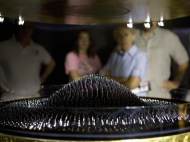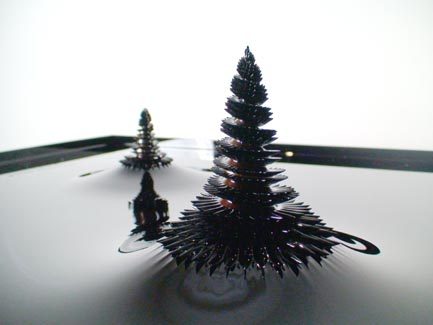Where art and technology meet – ferrofluid sculptures
 In one of our previous articles we started series about art and technology. We wrote about Theo Jansen and his Strandbeest. In this article we’re also going to write about kinetic sculptures, although animated in a completely different way. Human kind has ever since the ancient times used to make sculptures which cause admiration, and those were traditionally made of clay, stones, wood or metals. Modern art allows us to use different mediums and materials to display the artwork.
In one of our previous articles we started series about art and technology. We wrote about Theo Jansen and his Strandbeest. In this article we’re also going to write about kinetic sculptures, although animated in a completely different way. Human kind has ever since the ancient times used to make sculptures which cause admiration, and those were traditionally made of clay, stones, wood or metals. Modern art allows us to use different mediums and materials to display the artwork.
Sachiko Kodama graduated in physics and received a PhD in the Fine Arts Department at the University of Tsukuba where she studied Computer and Holography Art. Since year 2000, she had several projects with organic shape-changing art forms and figures whose three-dimensional form, surface structure, and color change dynamically and lively as if to reflect echoes of environmental music, light, and human communication. To create such three-dimensional organic forms and surfaces she used ferrofluids.
Basically, ferrofluids appear as a black fluid. They are prepared by dissolving nanoscale ferromagnetic particles in a solvent such as water or oil and remain strongly magnetic even in a fluid condition. Therefore, they are more flexibly transformable as compared to iron sand. It is well known that ferrofluids form spikes along magnetic field lines when the magnetic surface force exceeds the stabilizing effects of the fluid weight and surface tension.
“Rhythms of breathing in living things are an excellent metaphor for a texture that dynamically changes according to time. One of my eventual goals is to apply these elements in computer display design as well.”, Kodama said. She added “The continuously changing weather conditions of the earth are also important motifs. The motifs for the work ‘Morpho Towers: Two standing spirals’ which I created in collaboration with Yasushi Miyajima (Sony CSL), were ocean, tornadoes, and lightning.“
“Morpho Towers: Two Standing Spirals” is an installation that consists of two ferrofluid sculptures that moves synthetically to music. The two spiral towers stand on a large plate that hold ferrofluid. When the music starts, the magnetic field around the tower is strengthened. Spikes of ferrofluid are born from the bottom plate and move up, trembling and rotating around the edge of the iron spiral.
In this work, they altered the shape of the ferrofluid sculptures precisely by utilizing digital music metadata. To control the synchronization of the ferrofluid with the music playback in real time, time series metadata are added to the music ahead of time. The metadata consist of musical information, such as beat position, chord progression, and melody block information, and ferrofluid control information such as DC bias voltage and AC pattern. Each data record has a time stamp that indicates the timing of presentation. All data are stored in time-series order.
Another use of her work could be found in user interfaces of the future. Their form follows the flow since the shape of ferrofluid display emerges naturally under the balance of physical forces. While ferrofluid displays currently primarily serve as an output device, the electromagnet can be used directly as a sensor, allowing the introduction of feedback loops and interactivity in the artworks. Despite the amount of research and development needed to realize that idea, it is a good basis for new generation of tangible user interfaces.










Leave your response!